The AMD Radeon R9 Fury Review, Feat. Sapphire & ASUS
by Ryan Smith on July 10, 2015 9:00 AM ESTCompute
Shifting gears, we have our look at compute performance. As compute performance will be more significantly impacted by the reduction in CUs than most other tests, we’re expecting the performance hit for the R9 Fury relative to the R9 Fury X to be more significant here than under our gaming tests.
Starting us off for our look at compute is LuxMark3.0, the latest version of the official benchmark of LuxRender 2.0. LuxRender’s GPU-accelerated rendering mode is an OpenCL based ray tracer that forms a part of the larger LuxRender suite. Ray tracing has become a stronghold for GPUs in recent years as ray tracing maps well to GPU pipelines, allowing artists to render scenes much more quickly than with CPUs alone.

For LuxMark with the R9 Fury X already holding the top spot, the R9 Fury cards easily take the next two spots. One interesting artifact of this is that the R9 Fury’s advantage over the GTX 980 is actually greater than the R9 Fury X’s over the GTX 980 Ti’s, both on an absolute and relative basis. This despite the fact that the R9 Fury is some 13% slower than its fully enabled sibling.
For our second set of compute benchmarks we have CompuBench 1.5, the successor to CLBenchmark. CompuBench offers a wide array of different practical compute workloads, and we’ve decided to focus on face detection, optical flow modeling, and particle simulations.
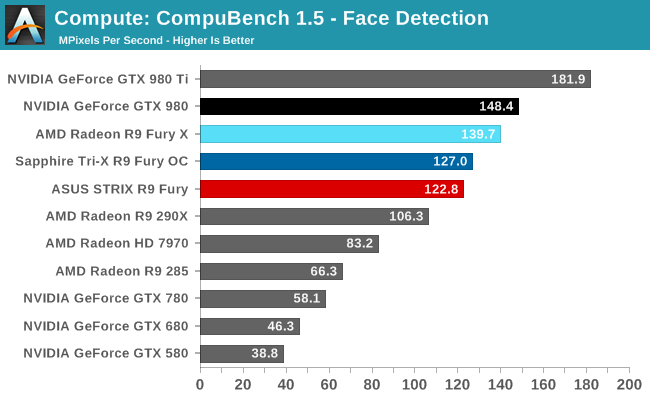
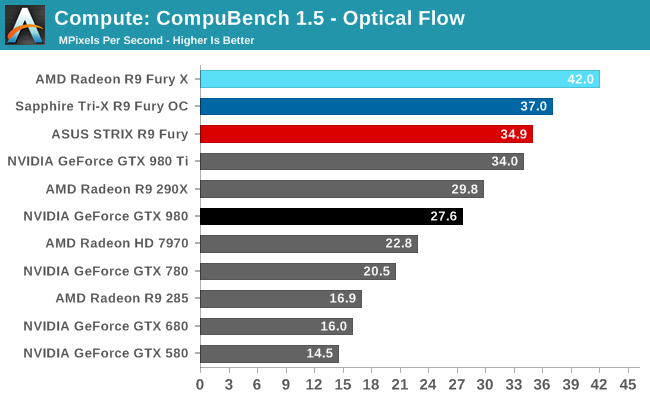

Not unlike LuxMark, tests where the R9 Fury X did well have the R9 Fury doing well too, particularly the optical flow sub-benchmark. The drop-off in that benchmark and face detection is about what we’d expect for losing 1/8th of Fiji’s CUs. On the other hand the particle simulation benchmark is hardly fazed beyond the clockspeed drop, indicating that the bottleneck lies elsewhere.
Our 3rd compute benchmark is Sony Vegas Pro 13, an OpenGL and OpenCL video editing and authoring package. Vegas can use GPUs in a few different ways, the primary uses being to accelerate the video effects and compositing process itself, and in the video encoding step. With video encoding being increasingly offloaded to dedicated DSPs these days we’re focusing on the editing and compositing process, rendering to a low CPU overhead format (XDCAM EX). This specific test comes from Sony, and measures how long it takes to render a video.
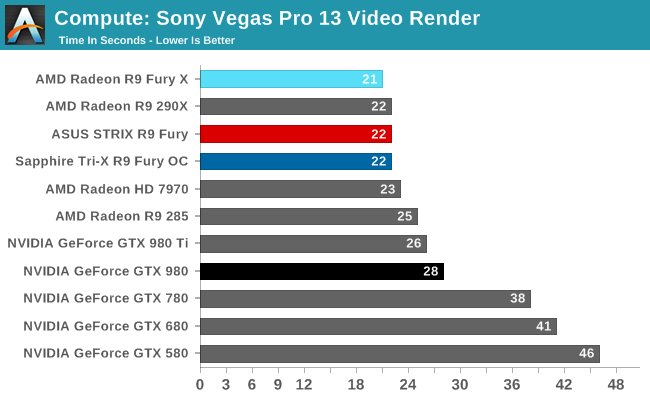
At this point Vegas is becoming increasingly CPU-bound and will be due for replacement. The R9 Fury comes in one second behind the chart-topping R9 Fury X, at 22 seconds.
Moving on, our 4th compute benchmark is FAHBench, the official Folding @ Home benchmark. Folding @ Home is the popular Stanford-backed research and distributed computing initiative that has work distributed to millions of volunteer computers over the internet, each of which is responsible for a tiny slice of a protein folding simulation. FAHBench can test both single precision and double precision floating point performance, with single precision being the most useful metric for most consumer cards due to their low double precision performance. Each precision has two modes, explicit and implicit, the difference being whether water atoms are included in the simulation, which adds quite a bit of work and overhead. This is another OpenCL test, utilizing the OpenCL path for FAHCore 17.
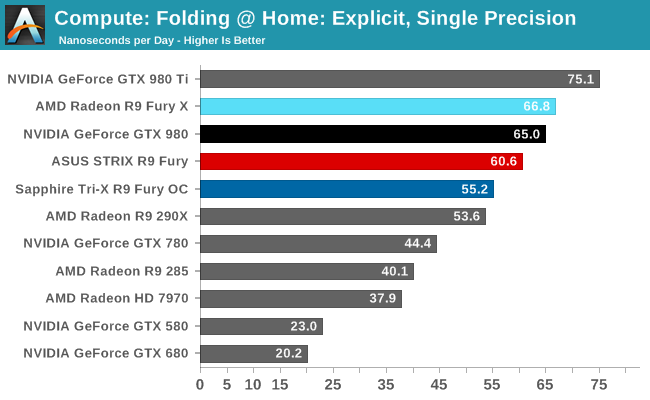
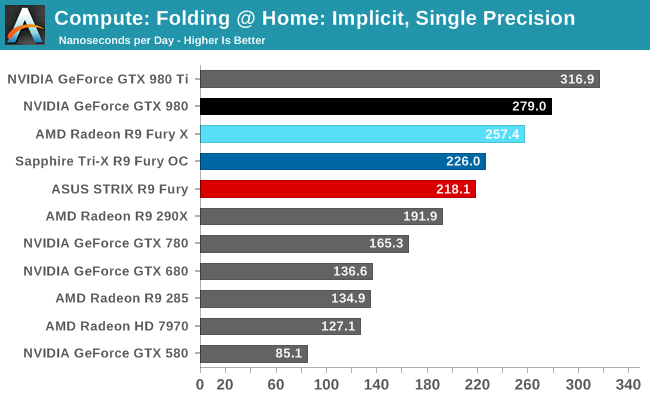

Overall while the R9 Fury doesn’t have to aim quite as high given its weaker GTX 980 competition, FAHBench still stresses the Radeon cards. Under single precision tests the GTX 980 pulls ahead, only surpassed under double precision thanks to NVIDIA’s weaker FP64 performance.
Wrapping things up, our final compute benchmark is an in-house project developed by our very own Dr. Ian Cutress. SystemCompute is our first C++ AMP benchmark, utilizing Microsoft’s simple C++ extensions to allow the easy use of GPU computing in C++ programs. SystemCompute in turn is a collection of benchmarks for several different fundamental compute algorithms, with the final score represented in points. DirectCompute is the compute backend for C++ AMP on Windows, so this forms our other DirectCompute test.
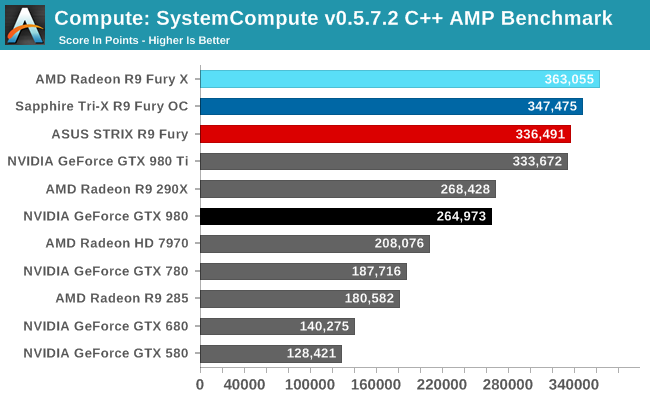
As with our other tests the R9 Fury loses some performance on our C++ AMP benchmark relative to the R9 Fury X, but only around 8%. As a result it’s competitive with the GTX 980 Ti here, blowing well past the GTX 980.










288 Comments
View All Comments
mickulty - Friday, July 10, 2015 - link
Looks fantastic! Definitely getting one of these once the stock is there.FlushedBubblyJock - Wednesday, July 15, 2015 - link
Yes paper launch for the r9 390X ... newegg is dry as a bone and just 15 reviews with zero stock only sapphire had about 10 cards to sell otherwise NO STOCK AT NEWEGG AT ALL.it's july 16th and the r9 390x is vapor
figus77 - Monday, July 20, 2015 - link
Got a Sapphire Fury Tri-X (non OC version) the 16/7 in Italy... probably is newegg problem... and really is a good card, with catalyst 15.7 i got very nice results... With my system 8320, 16gb 1600hz, in Tomb Raider 2560x1440 all maxed out with TressFX on, FPS MIN: 58,0 - MED: 75,3 - MAX: 94,0Really good results. Witcher3 run stable beetween 45 to 50 fps in ultra setting in 2560x1440 and that casr is really silent you can't hear anything even after some long time playing.
Jtaylor1986 - Friday, July 10, 2015 - link
Almost makes you wonder if AMD should have just designed the card with 54 compute units and would have had a winner on it's hand. Fury X seems to be somewhat unbalanced in terms of it's hardware configuration.Asomething - Friday, July 10, 2015 - link
This imbalance comes from gcn's limitations, amd tried to compensate with the extra shaders.Ranger101 - Friday, July 10, 2015 - link
Another quality Gpu review from Anandtech, in addition to being so early. Best of both worlds.jann5s - Friday, July 10, 2015 - link
The sapphire Tri-X cooling solutions performs impressively under load. I think this a consequence of the abysmal configuration forced on videocards by the ATX standard. The sapphire card can exhaust the hot air freely because of the short PCB, which proves we could use a replacement for ATX (or shorter PCB's)Ian Cutress - Friday, July 10, 2015 - link
It would be interesting to see the effect of having 2 or 3 cards in one system using that paradigm for sure.jann5s - Friday, July 10, 2015 - link
interesting for sure, any change sapphire will send another card?jann5s - Friday, July 10, 2015 - link
speaking of which, what happened to BTX?